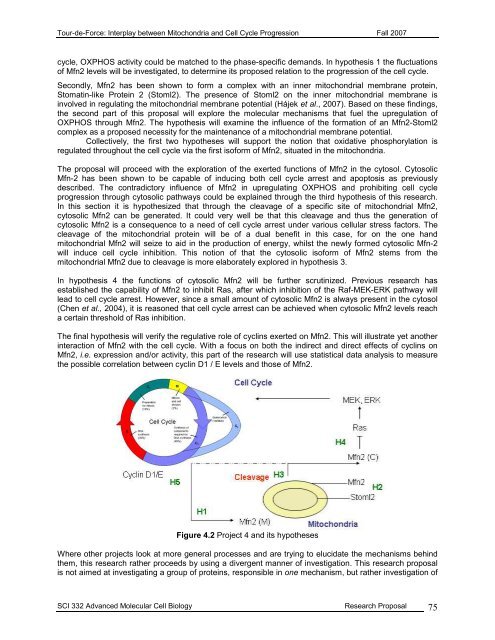Tour-de-Force
Tour-de-Force
Tour-de-Force
Create successful ePaper yourself
Turn your PDF publications into a flip-book with our unique Google optimized e-Paper software.
<strong>Tour</strong>-<strong>de</strong>-<strong>Force</strong>: Interplay between Mitochondria and Cell Cycle Progression Fall 2007cycle, OXPHOS activity could be matched to the phase-specific <strong>de</strong>mands. In hypothesis 1 the fluctuationsof Mfn2 levels will be investigated, to <strong>de</strong>termine its proposed relation to the progression of the cell cycle.Secondly, Mfn2 has been shown to form a complex with an inner mitochondrial membrane protein,Stomatin-like Protein 2 (Stoml2). The presence of Stoml2 on the inner mitochondrial membrane isinvolved in regulating the mitochondrial membrane potential (Hájek et al., 2007). Based on these findings,the second part of this proposal will explore the molecular mechanisms that fuel the upregulation ofOXPHOS through Mfn2. The hypothesis will examine the influence of the formation of an Mfn2-Stoml2complex as a proposed necessity for the maintenance of a mitochondrial membrane potential.Collectively, the first two hypotheses will support the notion that oxidative phosphorylation isregulated throughout the cell cycle via the first isoform of Mfn2, situated in the mitochondria.The proposal will proceed with the exploration of the exerted functions of Mfn2 in the cytosol. CytosolicMfn-2 has been shown to be capable of inducing both cell cycle arrest and apoptosis as previously<strong>de</strong>scribed. The contradictory influence of Mfn2 in upregulating OXPHOS and prohibiting cell cycleprogression through cytosolic pathways could be explained through the third hypothesis of this research.In this section it is hypothesized that through the cleavage of a specific site of mitochondrial Mfn2,cytosolic Mfn2 can be generated. It could very well be that this cleavage and thus the generation ofcytosolic Mfn2 is a consequence to a need of cell cycle arrest un<strong>de</strong>r various cellular stress factors. Thecleavage of the mitochondrial protein will be of a dual benefit in this case, for on the one handmitochondrial Mfn2 will seize to aid in the production of energy, whilst the newly formed cytosolic Mfn-2will induce cell cycle inhibition. This notion of that the cytosolic isoform of Mfn2 stems from themitochondrial Mfn2 due to cleavage is more elaborately explored in hypothesis 3.In hypothesis 4 the functions of cytosolic Mfn2 will be further scrutinized. Previous research hasestablished the capability of Mfn2 to inhibit Ras, after which inhibition of the Raf-MEK-ERK pathway willlead to cell cycle arrest. However, since a small amount of cytosolic Mfn2 is always present in the cytosol(Chen et al., 2004), it is reasoned that cell cycle arrest can be achieved when cytosolic Mfn2 levels reacha certain threshold of Ras inhibition.The final hypothesis will verify the regulative role of cyclins exerted on Mfn2. This will illustrate yet anotherinteraction of Mfn2 with the cell cycle. With a focus on both the indirect and direct effects of cyclins onMfn2, i.e. expression and/or activity, this part of the research will use statistical data analysis to measurethe possible correlation between cyclin D1 / E levels and those of Mfn2.Figure 4.2 Project 4 and its hypothesesWhere other projects look at more general processes and are trying to elucidate the mechanisms behindthem, this research rather proceeds by using a divergent manner of investigation. This research proposalis not aimed at investigating a group of proteins, responsible in one mechanism, but rather investigation ofSCI 332 Advanced Molecular Cell Biology Research Proposal 75
















